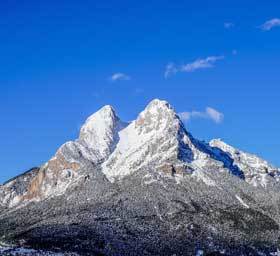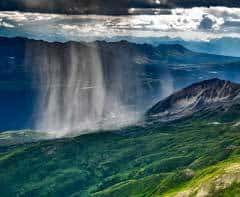How Altitude Affects Climate

If you live at or near the coast and travel inland to regions situated at higher altitudes, you quickly realize that the atmospheric conditions change significantly for some reason. The opposite is true as well.
A region located at a higher altitude generally experiences colder temperatures and lower air pressures than a region situated at sea level. This is a result of both temperature and air pressure reaching their highest values close to the surface of the Earth and decreasing as altitude increases.
At a few thousand feet or higher above sea level, the climate you experience is very different from the climate you will find in a coastal town. It all has to do with how weather elements change with an increase in altitude within the atmosphere.

This article examines what causes these changes in weather elements as altitude increase, and also look at the prevailing weather conditions in a location at a high altitude compared to the environment at sea level.
A quick word about climate: There are similarities but also significant differences between weather and climate. Weather is the atmospheric condition at any given time at a specific location.
Climate, however, is the average atmospheric conditions in a specific location calculated over a prolonged period. (At least 30 years in most cases.) You can read the in-depth article describing the difference between Weather and Climate by following this link.
How Does Altitude Affect Climate?
Before we look at what the climate conditions are like at a location a few thousand feet above sea level and then contrast it against a similar environment at sea level, one needs to see how an increase in altitude affects the different weather variables:
But first, one needs to address the difference between altitude and elevation.
Altitude vs. Elevation
In meteorology and aviation, altitude generally refers to an object/location's height above sea level. Elevation, though, refers to the height of an object relative to the physical terrain (ground level) beneath it.
In aviation, altitude also has a few different meanings. Here is a quick summary:
- Indicated Altitude: The altitude displayed on the altimeter.
- Absolute Altitude: The distance between the aircraft and the ground below it.
- True Altitude: The height of the aircraft above sea level.
- Height: The vertical distance between the aircraft and a specific point below it.
Pressure and Density Altitude also gets used, but it may make things too confusing and is not relevant to the context within which this article uses altitude.
For the purpose of this post, altitude will always refer to an object's height above sea level.
One can now focus on the different elements and how altitude affects them:
How Does Altitude Affect Temperature?
The Earth and atmosphere get warmed up as a result of the sun's solar radiation, specifically the infrared component of solar radiation. The infrared radiation warms up the land and oceans, which, in turn, warms up the air in the atmosphere.

Since the atmosphere gets warmed up from the bottom up, the air is usually at its warmest at the surface of the planet and cools down as altitude increases.
Although local variable conditions will influence the following figures, temperatures usually drop at a rate of 1° Celsius per 100 meters. More broadly put, temperatures fall by 5.4° Fahrenheit per 1 000 feet or 9.8° Celsius every 1 000 meters.
For example, a town can have a temperature of 22° Celsius (71.6° Fahrenheit) at sea level. When the same village gets placed at a height of 2 000 meters (6561 feet) on a plateau, it can be as cold as 3.4° Celsius (38.1° Fahrenheit).
How Does Altitude Affect Air Pressure?
Atmospheric air has weight. It is not empty but consists of nitrogen, oxygen, argon, and other gases like carbon dioxide and methane. It also contains small particles like dust and pollen. This fact alone will help to explain the relationship between altitude and air pressure.
At the surface of the planet, you have the whole weight of the atmosphere (specifically the troposphere) pressing down on you. The Earth's gravity is also at its strongest at surface level, causing the air particles close to the ground to compress the most.
As an object starts to gain altitude, the atmospheric pressure around it begins to decrease. It is as a result of two factors. Firstly, with an increase in height, the amount of air above the subject starts to lessen, meaning the weight of air pressing down on it gets less as well.
Secondly, the more altitude you gain, the further you are from the Earth's surface and its gravitational forces, so you experience less gravity. It allows the particles in the air to expand, which reduces the air pressure even further.
In the upper troposphere and lower stratosphere, the atmospheric pressure is almost non-existent. The lack of oxygen is what makes life at this altitude impossible, but the thin air also allows airliners to fly without much air resistance and above any unstable weather.
How Does Altitude Affect Precipitation?
As already mentioned earlier in this post, temperatures continue to decrease as altitude keeps increasing. Atmospheric pressure also continues to drop with an increase in height.

The combination of both processes contributes to locations at higher altitudes receiving a significantly higher amount of precipitation than low-lying regions. Please note that sufficient moisture must be present in the air for any precipitation to take place.
The type of precipitation, however, depends on how low the temperature has dropped when condensation takes place.
When condensation takes place while the temperature is above freezing point, precipitation is usually in the form of rain. When the water vapor condenses in sub-zero temperatures, though, it will be in the shape of snow or another solid form of water.
Sometimes other factors such as physical barriers cause air to rise as well. The mountain effect is one such case. A change in the elevation of the physical terrain and not natural atmospheric processes forces air to gain altitude.
Wind forces moisture-filled air to rise against a mountain, condensate, and result in precipitation on the windward side of the mountain, with warm, dry air flowing down on the leeward side. You can read all about this effect and how it occurs in this article.
The Difference In Climate Between Low-Lying And Regions At High Altitudes
Many of the climate conditions that are a result of an increase in altitude were highlighted throughout this post. A summary of these different conditions will explain just what a crucial role altitude plays in establishing the climate of any location.
The best way to summarize the key differences between regions separated by altitude is to list the different weather conditions each one experience. (Just note that there are many other variables involved in forming the climate of any region.)
Low-lying areas are typically characterized by:
- Warmer temperatures
- Less wind activity
- Lower amounts of precipitation
- Higher air pressure with high levels of oxygen
High-altitude areas are typically characterized by:
- Colder temperatures
- Strong and gusty winds
- High amounts of precipitation
- Lower air pressure with low levels of oxygen
As previously mentioned, these climate conditions can occur under a variety of conditions but are typical of the difference between locations at low and high altitudes.
Conclusion
As this article clearly illustrated, altitude causes lower-lying areas to have a very different climate than regions situated at a high altitude. If you experience any of the climate conditions described at the associated altitude, you now know why.
Never miss out again when another interesting and helpful article is released and stay updated, while also receiving helpful tips & information by simply clicking on this link .
Until next time, keep your eye on the weather!
